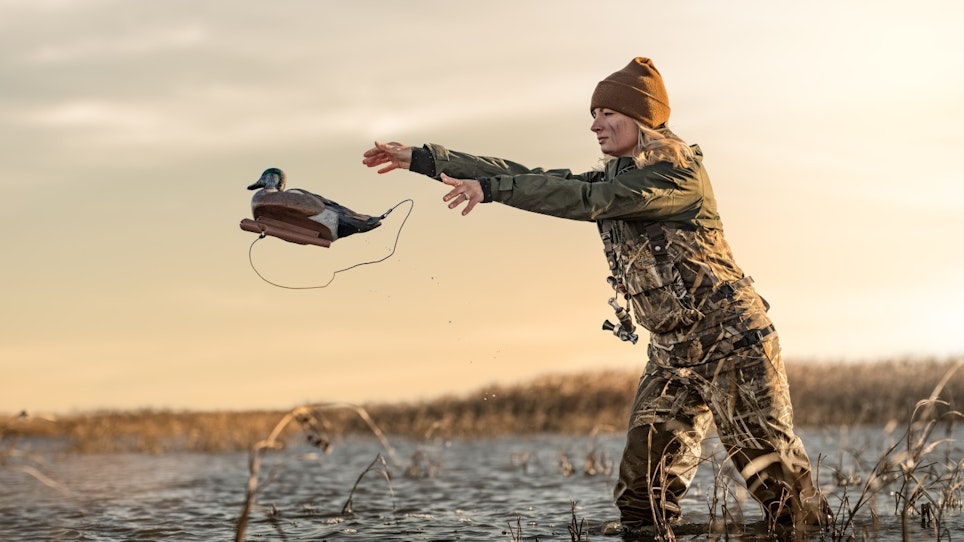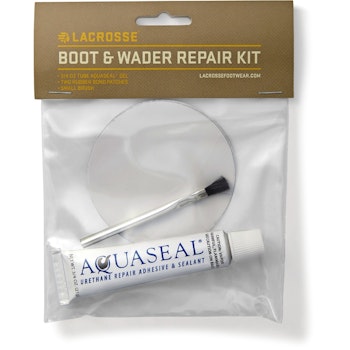While waders have improved greatly over the years from the canvas and rubber variants that were prone to dry rot to the advanced materials of today, that doesn’t make selecting the most appropriate choice any easier. Waders, both for hunting and fishing, come in many different styles, materials and insulation factors, requiring careful consideration through application of the end-user’s use case prior to purchase. Equipped with the necessary knowledge, making the sale and putting your customer in the right set is as easy as selling them the right caliber of ammunition for their firearm.
While wader styles vary per brand, the materials/types of most modern waders are the same. As you already know, waders are generally available in two material choices — breathable and neoprene. Within these material choices lies different thicknesses, different boot styles, and a plethora of other features consisting of belt loops, knee pads, handwarmer pockets, etc. The first two choices above should be used to help define the appropriate wader for a user’s specific use case, while the gingerbread features should be considered a buyer’s preference and used as a selling point to a specific buyer. In all cases, having in-depth knowledge of the pros and cons of each type and manufacturer is what will place a buyer in the best possible pair of waders for their situation.
Materials
The two most popular material choices, as stated above, are breathable, sometimes referred to all-season, and neoprene. Both of these choices, when cared for appropriately, will provide the user many seasons of worry-free use provided they don’t use them to bust through a thorn thicket on the way to the water. If a user does require something that will handle brush thickets and is more puncture resistant, there are a few manufacturers that make briar-proof or canvas waders that they should be directed towards, as the other two choices will not withstand this type of abuse, leading to an unhappy customer and attempted warranty claims.
Breaking down the differences between breathable and neoprene starts with understanding the temperature range they will be worn in. If a hunter or fisherman predominately needs waders for warmer climates or seasons, the best choice is a breathable, all-season wader that will keep the user cooler in hot temperatures while minimizing dampness due to sweating. This type of wader has gained greater popularity in recent years, as they can also be used in cooler temperatures with the appropriate layering system underneath and are generally more comfortable to wear. Companies including LaCrosse, Banded, Frogg Toggs and Sitka Gear make versions of this style of wader, and they are quickly becoming the go-to for users who want one wader for every situation. For users who like what all-season waders offer but need a little added warmth, some versions of these waders are available with a thin layer of insulation underneath the outer material.
On the flip side, neoprene waders are generally bulkier and heavier, but they offer supreme warmth in cold temperatures and greater durability when compared to all-season waders in rocky streams or mild brush. Their main pitfall is that they can make a user unbearably hot in warm temperatures, especially when a user is active, causing a lot of dampness inside the wader. This is also problematic when a user is active setting decoys or walking to their fishing spot, then standing rather motionless for hours while the dampness from their own sweat causes them to get cold. A great use case for neoprene waders is for users who frequently stand in cold water for extended periods or hunt in sub-zero temperatures. While all-season waders and layering can keep users warm when standing outside the water, when standing in water, there is a greater cold transfer to the body with all-season compared to neoprene waders that some users find undesirable. This is where neoprene waders excel and are the appropriate recommendation.
Neoprene waders are also available in two thicknesses — 3 and 5mm. As expected, 3mm neoprene waders are lighter in weight than their 5mm counterpart, but they don’t offer as much warmth or ruggedness. For extreme cold, 5mm is best, but for mild conditions, 3mm will be a much more comfortable choice. Aside from the thickness, there are no other appreciable differences between these wader styles.
Boot Types and insulation
Both wader material types mentioned above are available in a stocking-foot or boot-foot variation from different manufacturers. For hunters, except in special cases, boot-foot is the most appropriate choice. For fisherman, it can go either way, and that decision should be made based on the use-case. Stocking-foot waders equipped with a felt sole boot/shoe excel in streams, providing added traction on slippery, moss-covered rocks. They can also be less clumsy to walk in and are generally more comfortable for walking long distances, as the boot is more secure than a standard slip-on wader. Hunters may benefit from these advantages, so don’t overlook pitching stocking-foot waders to hunters who would otherwise overlook them.
While most users gravitate toward the slip-on boot-foot style of waders for an all-purpose use, a common question is how much Thinsulate to get in the boot. While options vary by manufacturer, with some waders having no insulation and others having 1600 or more grams, the user must ultimately decide. Good socks can make up the difference for an under-insulated boot, but an over-insulated boot will lead to sweating and ultimately getting cold feet if too much moisture builds up in the boots. This is a good time for retailers to bring up the need for good synthetic or wool stocks instead of cotton, as a wool liner sock underneath a heavy wool sock can outperform even the best Thinsulate in some situations.
Other Considerations
An often-overlooked attribute of waders is their transportability and comfort for day-after-day use. For hunters or fisherman who travel or hunt/fish day after day, neoprene waders take longer to dry out, especially the inside, and they retain water, making them heavy. All-season waders, on the other hand, dry out quickly and are much lighter when they are dry and significantly lighter when wet. This means less weight and less bulk in a suitcase — an especially important attribute for traveling hunters and anglers who are flying out in the afternoon after a morning’s outing on the water.
Features, features, features! Outdoor enthusiasts love neat features and gadgets, so make sure to thoroughly understand what specific brands or wader types offer the user. Not all wader types/brands are the same, and just like trucks, sometimes the features are what differentiates them to a prospective buyer. Sometimes a simple feature like a reinforced knee or a shell loop matters to the buyer, so being able to point them out goes a long way to making them comfortable that the seller is the expert on what they are looking to purchase.
Did you know certain brands make waders specifically for women? With increasing amounts of women outdoorsman, don’t be unprepared when a woman shopper is looking at wader choices. Generally speaking, most wader types are cut for the leg and torso length of a male, making them uncomfortable and downright awful to wear for those not cut from that mold. Lacrosse, for example, makes a full line of waders cut specifically for women that are designed to fit them comfortably. Additionally, while some manufacturers make youth waders, don’t overlook waders made for women to try out on a youth. Just like men and women, not all young people fit into the same fit-mold, and a women’s cut might be the most appropriate choice for a comfortable fit on a youngster.
Making the Sale
When a prospective buyer asks about which wader type to buy, the response should start with a question about the buyer’s use case. Are they looking for something to wear for summer fishing, late-season duck hunting, or for every season? Follow up that question with some scenario-specific questions like the amount of activity during each outing, the environment they will be using them in (rocky river or brushy shorelines), and how often they travel to hunt or fish. With those characteristics in mind and the information above, sellers can easily provide a few appropriate choices that are specific to the user’s application.
Additionally, all waders will have different features, so make sure to point out the items that will make the waders more user-friendly for a prospective buyer’s particular use case. For instance, one style of wader might have a built-in handwarmer pocket that a waterfowl hunter might enjoy or a one-sided shoulder strap that won’t interfere with shouldering a shotgun. If you can provide the buyer choices based on their actual needs, they will quickly become more comfortable with their selection and their future purchase, likely seeing the you as the expert they have been looking for.
Sidebar
Wader Repair
Even the best-maintained waders are susceptible to a leak. Sometimes that leak is induced by a sharp rock, while other times is was crossing the guardrail to get to the stream. In a pinch, duct tape will work to temporarily fix a leaking wader, but ultimately, something more permanent will be required to appropriately fix waders to keep them in service.
While there are many different types of wader patch kits available, Aquaseal is a favorite of many frequent wader users, especially for boot repair. Make sure that the kit being sold will repair the material type of the waders being repaired. For instance, some patch kits will cover both materials, while others may be designed for only all-season wader styles.
To complete the repair, a user must first clean the damaged area thoroughly to provide a good bond between the material and the patch cement or glue. Next, they should clean up the damaged area so that the cut closes cleanly. Once the area is clean, it’s a matter of following the manufacturer’s instructions, applying the glue and patch in the appropriate quantities, and allowing the patch to dry thoroughly before stressing the area or immersing it in water. In some areas, wader patches may last longer than the waders themselves, but in other more high-stress areas, the patch may need refreshing every year until you can convince the user to buy a new pair of waders.








